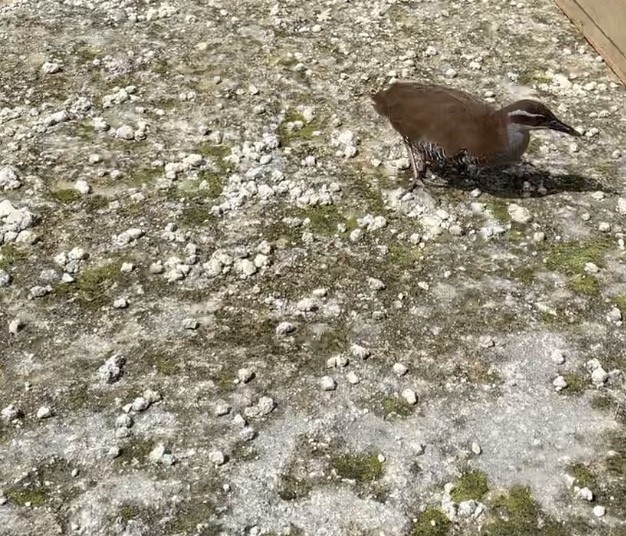Guam Rail
A species of Australasian-pacific Rails Scientific name : Hypotaenidia owstoni Genus : Australasian-pacific Rails
Guam Rail, A species of Australasian-pacific Rails
Botanical name: Hypotaenidia owstoni
Genus: Australasian-pacific Rails
Content
Description General Info
 Photo By cap1096 , used under CC-BY-NC-4.0 /Cropped and compressed from original
Photo By cap1096 , used under CC-BY-NC-4.0 /Cropped and compressed from original Description
It is a medium-sized rail about 11 inches (28 cm) in total length. The body is elongated and laterally compressed, particularly in the neck and breast regions, allowing the birds to move rapidly through dense vegetation. The plumage or feather color and pattern of both sexes is similar, however males can often be distinguished by their larger size. The head and back are brown. It has a grey eye stripe and throat, a dark blackish breast with white barring, and the legs and beak are dark brown. 
Size
28 cm
Nest Placement
Ground
Feeding Habits
Guam Rail consumes a diverse diet, including snails, insects, geckos, vegetation, and carrion. This rail forages on the ground, stretches up to 40cm for food, and is active primarily at dawn, dusk, and night. Unique to its diet are items like the introduced Achatina fulica snail.
Habitat
Guam Rail is typically found in a variety of habitats, excluding the interiors of mature forests and wetland environments. Their preferred habitats include secondary grasslands, scrubby growth, mixed woodlands, and areas with dense fern thickets. Guam Rail often inhabits areas alongside roads and under infrastructure like telephone lines. The species adapts well to disturbed or transformed habitats as opposed to undisturbed old-growth forests. This adaptability is attributed to their omnivorous diet which includes invertebrates, small reptiles, carrion, seeds, and foliage.
Dite type
Herbivorous
General Info
Feeding Habits
Bird food type
Species Status
Zoologist Bob Beck, a Guam Department of Agriculture Division of Aquatic and Wildlife Resources wildlife supervisor, is credited with leading the efforts to capture the remaining wild Guam rails, Guam kingfishers and other native birds to save them from extinction. His efforts to save the Guam rail began in 1982 and lasted more than 20 years. Beck was considered to be instrumental in capturing the remaining population of Guam rails and establishing captive breeding programs for the species on Guam. He later established a release site and an introduced breeding population of Guam rails on the neighboring island of Rota in the Northern Mariana Islands. Beck was also a driving force in establishing Guam rail breeding programs in zoos throughout the mainland United States. Beck's Guam rail breeding program initially began with just three zoos in the U.S. – the Bronx Zoo, the Philadelphia Zoo and the National Zoo in Washington, D.C. The program proved to be successful and was soon expanded to include other zoos. Seventeen zoos now participate in the Guam rail breeding program, as of 2008, including the Audubon Zoo in New Orleans, the San Diego Zoo, the Santa Fe College Teaching Zoo, and zoos in Chicago, Houston and San Antonio. The efforts by Beck, and others, to save the Guam rail have been promising. There are now approximately 120 Guam rails in captivity in Guam and approximately 35 birds in captive breeding programs throughout the United States. Biologist Gary Wiles, who worked on the Guam rail breeding program from 1981 through 2000, said of Beck's efforts to save the Guam rail, "Bob was one of the first to begin organizing catching the birds so they could be brought into captivity, held there and bred. He started a captive population. We still have Guam rails today because of his efforts." Suzanne Medina, a wildlife biologist, also credited Beck with saving the Guam rail, "Bob Beck was the ko'ko' champion, was Guam's champion at the time for preventing the extinction of these birds." A recent effort to introduce rails on Guam in a 22 hectare forested area concentrated on protecting the rails by limiting snakes using a combination of trapping and a perimeter barrier to reduce re-invasion by snakes. This endeavor allowed the tentative survival of several pairs of rails released into the area. Reproduction by the rails was reported in this control area on the basis of sounds attributed to chicks. The preliminary success constitutes one of the few bright spots in the conservation of Guam's native fauna in recent years and speaks to future opportunities to recover wildlife. In November 2010, 16 Guam rails were released on Cocos Island, a 33 hectare small atoll 1 mile off the coast of the southern tip of Guam as part of its reintroduction two decades after its extinction in the wild. It was an effort to provide safe nesting areas for the rails, as well as a place for the public to see them in the wild. Before the reintroduction, rats were eradicated off the island and the forest was further enhanced with native trees. A native lizard survey was conducted to make sure that the rails had enough food to eat. Monitor lizard populations were reduced to minimize their impacts of the newly released rails. The reintroduction proved to be successful as evidence of breeding have been observed. This will provide a model environment to develop strategies for future reintroductions as well as expertise in rodent and snake detection, eradication, and bio-security measures. 